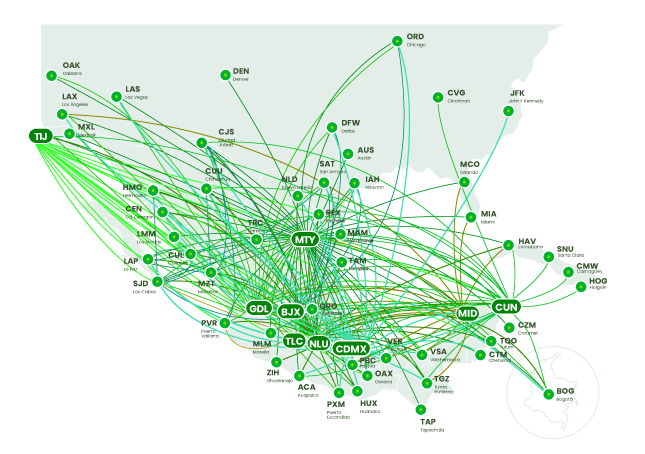

Inició sus operaciones en noviembre 2006 con dos aviones y una base en Monterrey
0.07 mm
Inaugurada la 3ª base en el aeropuerto de Ciudad de México
3.2 mm
Apertura de la 4ª base en Cancún y nuevo pedido de 55 nuevos Airbus A320
4.0 mm
1ª entrega de un A320. Viva se convierte en la 4ª compañía aérea del mercado nacional
4.2 mm
5ª baseTijuana. Firmado un nuevo pedido de 25 nuevos Airbus A321neo
10.0 mm
Alcanzamos 12.0 millones de pax, 11.4 nacional and 0.6 internacional.
12.0 mm
1ª entrega del A321 en junio de 2020
8.1 mm
Alcanzamos 15.3 millones de pax, 13.3 nacional and 2.0 internacional.
15.3 mm
Lanzamiento de Doters y marca compartida con HSBC. 100 millones de pasajeros desde 2006.
20.7 mm
Firma de un Memorando de Entendimiento por 90 Airbus A321. 6ª base en Mérida
25.0 mm
Alcanzamos 90 AC y más de 27 millones de pax. Alcanzamos el #1 en cultura de empleados en México
27.7 mm
Pasajeros reservados al año Flota al final del período

Tasa anual de crecimiento compuesto (TACC) en pasajeros e ingresos de 39.4% y 49.4%, respectivamente, en el periodo de 2006-2024.
Apalancamiento de 1.5x a diciembre 2024.
TRASM de US $10.77 centavos
Margen EBITDAR de 42.4%
Margen de Utilidad neta de 8.9%
De 2006 a 2024, los pasajeros incrementaron a una TACC de 39.4%, mientras los ingresos crecieron a una TACC de 49.4%
Apalancamiento de 1.5x al cierre del 4T24.
CASM de US $8.55 centavos (4T 2024)
TRASM de US $10.77 centavos (4T 2024)
Margen EBITDAR de 42.4% al cierre del 4T24